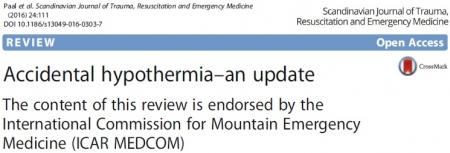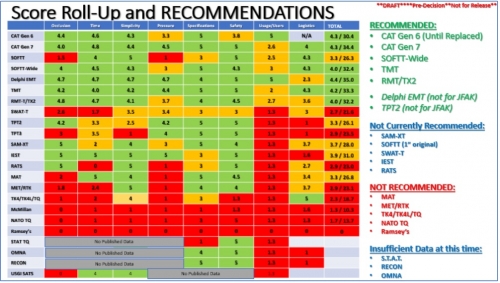27/12/2019
Hypothermia: Up to Date
| Tags : hypothermie
Hypothermie: On doit mieux faire
Hypothermia in trauma victims at first arrival of ambulance personnel: an observational study with assessment of risk factors.
-------------------------------------------
Malgré les diverses recommandations portant sur le réchauffement préhospitalier, cette mesure de prévention de l'hypothermie demeure insuffisament prise en compte. Ce travail, dans lequel seul 50%es patients pris en charge bénéficient d'un réchauffement préhospitalier, le rappelle.
-------------------------------------------
BACKGROUND:
Hypothermia is common in trauma victims and is associated with increased mortality, however its causes are little known. The objective of this study was to identify the risk factors associated with hypothermia in prehospital management of trauma victims.
METHODS:
This was an ancillary analysis of data recorded in the HypoTraum study, a prospective multicenter study conducted by the emergency medical services (EMS) of 8 hospitals in France. Inclusion criteria were: trauma victim, age over 18 years, and victim receiving prehospital care from an EMS team and transported to hospital by the EMS team in a medically equipped mobile intensive care unit. The following data were recorded: victim demographics, circumstances of the trauma, environmental factors, patient presentation, clinical data and time from accident to EMS arrival. Independent risk factors for hypothermia were analyzed in a multivariate logistic regression model.
RESULTS:
A total of 461 trauma patients were included in the study. Road traffic accidents (N = 261; 57%) and falls (N = 65; 14%) were the main causes of trauma. Hypothermia (<35 °C) was present in 136/461 cases (29%). Independent factors significantly associated with the presence of hypothermia were: a low GCS (Odds Ratio (OR) = 0,87 ([0,81-0,92]; p < 0.0001), a low air temperature (OR = 0,93 [0,91-0,96]; p < 0.0001) and a wet patient (OR = 2,08 [1,08-4,00]; p = 0.03).
CONCLUSION:
The incidence of hypothermia was high on EMS arrival at the scene. Body temperature measurement and immediate thermal protection should be routine, and special attention should be given to patients who are wet.
| Tags : hypothermie
21/12/2019
Crico Chir:Plutôt avec 1 bougie ?
Randomized Comparative Assessment of Three Surgical Cricothyrotomy Devices on Airway Mannequins.
-------------------------------------------------
Un travail qui met en avant l'intérêt de l'emploi d'une bougie, l'importance de l'entraînement pour cette procédure peu fréquemmment réaloisée et le recul nécessaire à avoir envers les nouveaux équipements , en l'occurence le control-cric, fussent ils promus par le TCCC.
-------------------------------------------------
Background:
Airway obstruction is the second leading cause of preventable battlefield death, at least in part because surgical cricothyrotomy (SC) failure rates remain unacceptably high. Ideally, SC should be a rapid, simple, easily-learned, and reliably-performed procedure. Currently, 3 SC devices meet Tactical Combat Casualty Care (TCCC) standards: The Tactical CricKit® (TCK), Control-CricTM(CC), and Bougie-assisted Technique (BAT). However, no previous studies have compared these devices in application time, application success, user ratings, and user preference.
Methods:
United States Navy Corpsmen (N = 25) were provided 15 minutes of standardized instruction, followed by hands-on practice with each device on airway mannequins. Participants then performed SC with each of the 3 devices in a randomly assigned sequence. In this within-subjects design, application time, application success, participant ratings, and participant preference data were analyzed using repeated-measures ANOVA, regression, and non-parametric statistics at p < 0.05.
Results:
Application time for CC (M = 184 sec, 95% CI 144-225 sec) was significantly slower than for BAT (M = 135 sec, 95% CI 113-158 sec, p < 0.03) and TCK (M = 117 sec, 95% CI 93-142 sec, p < 0.005). Success was significantly greater for BAT (76%) than for TCK (40%, p < 0.02) and trended greater than CC (48%, p = 0.07). CC was rated significantly lower than TCK and BAT in ease of application, effectiveness, and reliability (each p < 0.01). User preference was significantly (p < 0.01) higher for TCK (58%) and BAT (42%) than for CC (0%). Improved CC blade design was the most common user suggestion.
Conclusion:
While this study was limited by the use of mannequins in a laboratory environment, present results indicate that none of these devices was ideal for performing SC. Based on slow application times, low success rates, and user feedback, the Control-CricTM cannot be recommended until improvements are made to the blade design
| Tags : coniotomie
En attendant le REBOA: Une paire de main ou un genou !
Proximal External Aortic Compression for Life-Threatening Abdominal-Pelvic and Junctional Hemorrhage: An Ultrasonographic Study in Adult Volunteers.
INTRODUCTION:
Following life-threatening junctional trauma, the goal is to limit blood loss while expediting transfer to operative rescue. Unfortunately, life-threatening abdominal-pelvic or junctional hemorrhage is often not amenable to direct compression and few temporizing strategies are available beyond hemostatic dressings, hypotensive resuscitation, and balanced transfusion.
OBJECTIVES:
In this study, we evaluated proximal external aortic compression to arrest blood flow in healthy adult men.
METHODS:
This was a simulation trial of proximal external aortic compression, for life-threatening abdominal-pelvic and junctional hemorrhage, in a convenience sample of healthy adult male volunteers. The primary end points were cessation of femoral blood flow as assessed by pulse wave Doppler ultrasound at the right femoral artery, caudal to the inguinal ligament. Secondary end points were discomfort and negative sequelae.
RESULTS:
Aortic blood flow was arrested in 12 volunteers. Median time to blood flow cessation was 12.5 seconds. Median reported discomfort was 5 out of 10. No complications or negative sequelae were reported.

CONCLUSION:
This trial suggests that it may be reasonable to attempt temporization of major abdominal-pelvic and junctional hemorrhage using bimanual proximal external aortic compression. In the absence of immediate alternatives for this dangerous and vexing injury pattern, there appear to be few downsides to prehospital proximal external aortic compression while concomitantly expediting definite care.
18/12/2019
Recommandations aux voyageurs 2022
04/12/2019
HEA 130: Protègerait le glycocalyx ?
The protective effect of hydroxyethyl starch solution on the glycocalyx layer in an acute hemorrhage mouse model.
- --------------------------------------------------------
Le recours au HEA pour le remplissage vasculaire est très décrié notamment à cause d'effets rénaux délétères observés tout particulièrement en cas de sepsis. Les HEA peuvent néanmoins être utilisés en cas de non restauration de l'hémodynamique après emploi de cristalloides isotoniques et en attendant les produits de transfusion (reco 6 de la RFE sur le choc hémorragique). Ce travail semble donc tempérer un peu le rejet des HEA pour la réanimation du choc hémorragique. Il montre une moindre élévation de syndecan-1 lors de l'emploi d'HEA 130 qu'après Salé.
--------------------------------------------------------
PURPOSE:
Fluid therapy focused on glycocalyx (GCX) protection in hemorrhagic shock is a current focus of research. Hydroxyethyl starch (HES) solution is commonly used for fluid resuscitation; however, its effects on the GCX remain unclear. The primary aim of this study was to explore the protective effect of HES130 in maintaining GCX thickness and reducing plasma syndecan-1 expression.
METHODS:
An acute hemorrhage murine model with the dorsal skin chambers was used to measure GCX thickness and to evaluate vascular permeability. Groups of mice were treated with normal saline (NS), albumin (NS-A), HES130 (NS-V), or no exsanguination or infusion (C). We measured syndecan-1 plasma concentrations, performed blood gas analysis, and analyzed the 7-day cumulative mortality.
RESULTS:
GCX thickness in NS mice was significantly reduced compared to that in group C, but no other groups showed a difference compared to group C. The plasma concentration of syndecan-1 was significantly higher in NS mice than in group C. There were no significant differences in the fluorescence intensity of dextran in the interstitial space. HES70 leakage was suppressed in NS-V mice compared to those in other groups. HES70 was localized to the inner vessel wall in C, NS, and NS-A mice, but not in group NS-V. Blood gas analysis indicated that pH and lactate showed the greatest improvements in NS-V mice. The 7-day cumulative mortality rate was the highest in group NS.
CONCLUSION:
Resuscitation with HES130 protected the GCX and suppressed vascular permeability of HES70 during early stages of acute massive hemorrhage.
01/12/2019
Quel tourniquet ?: Cela évolue, un peu
| Tags : tourniquet



